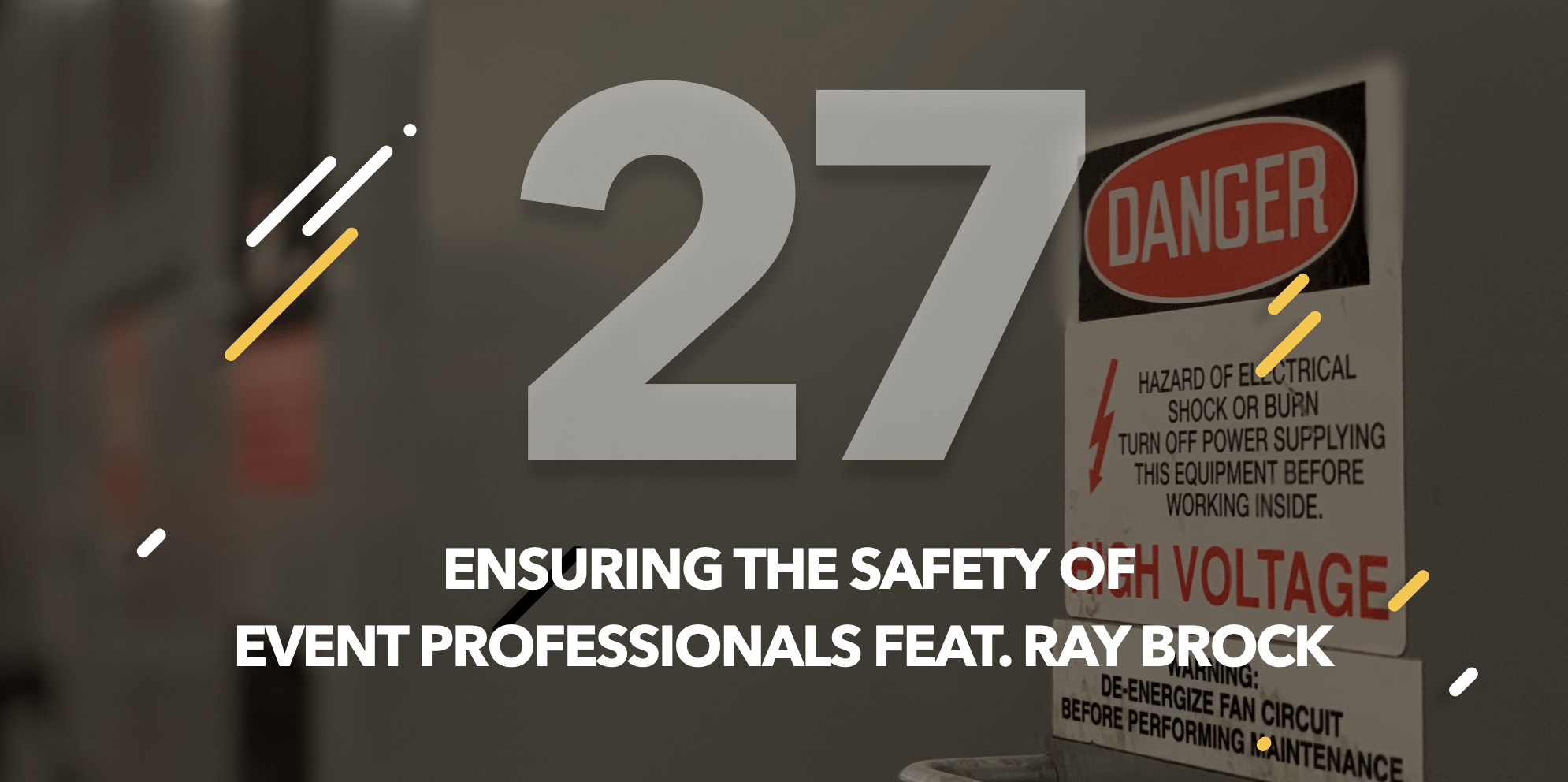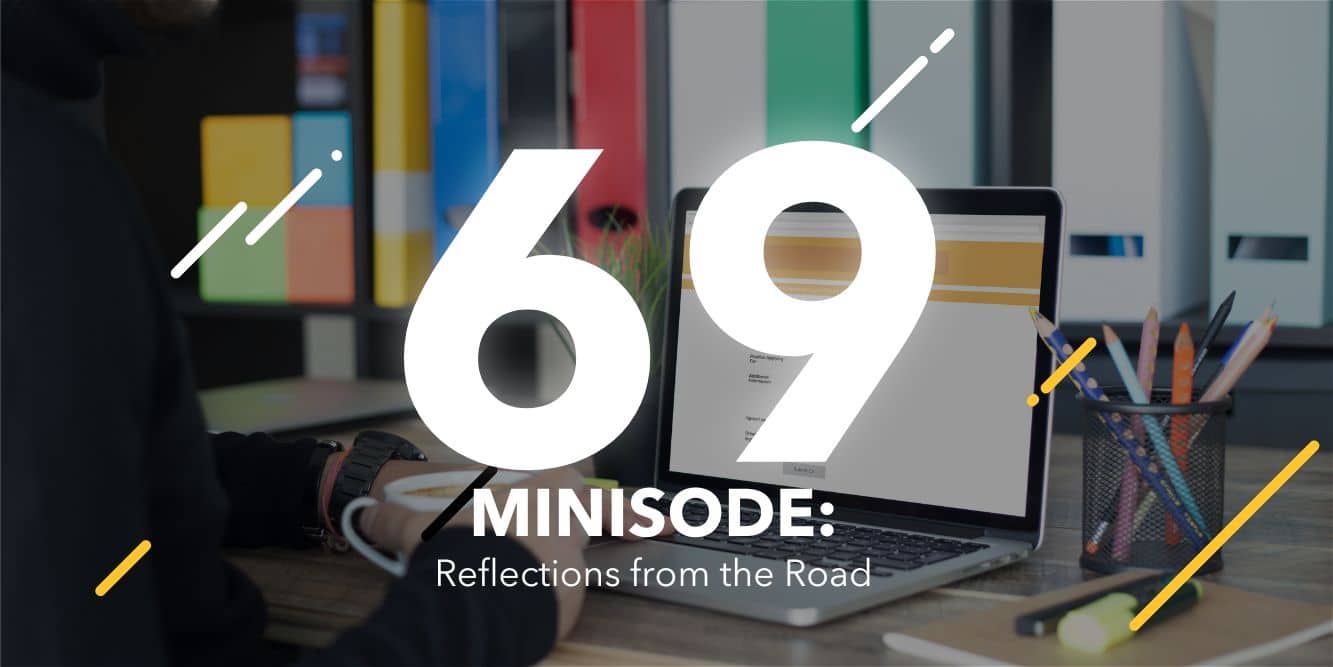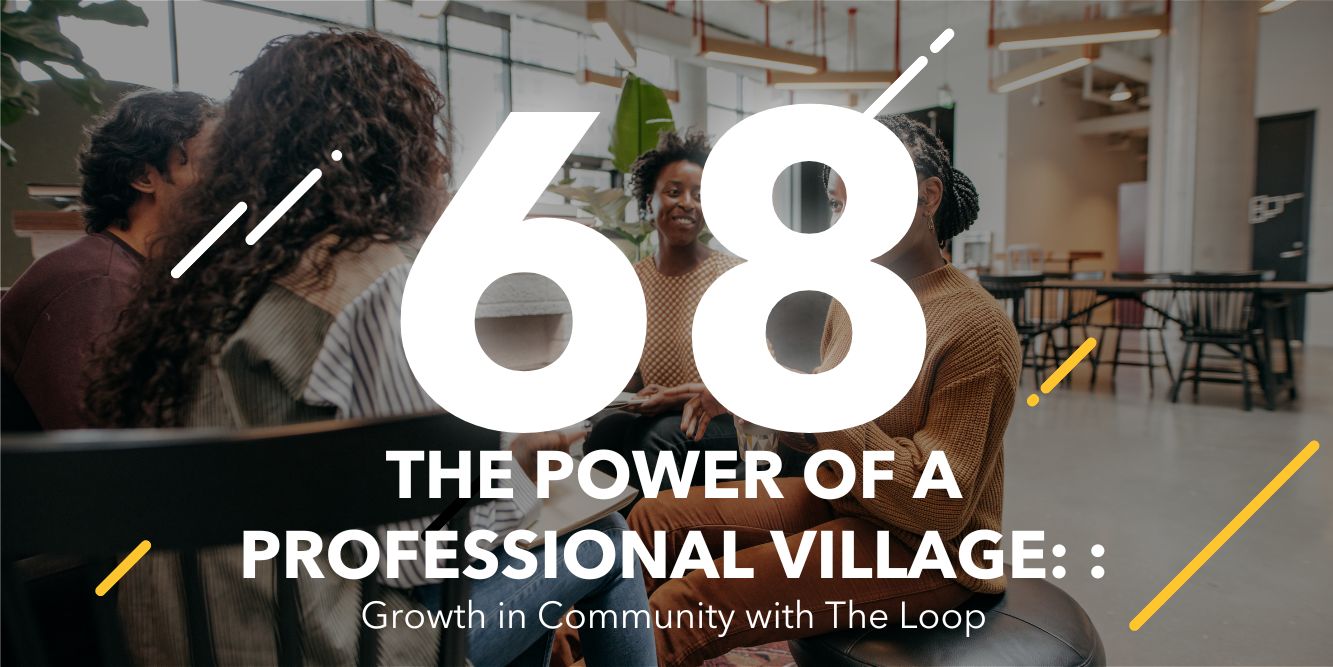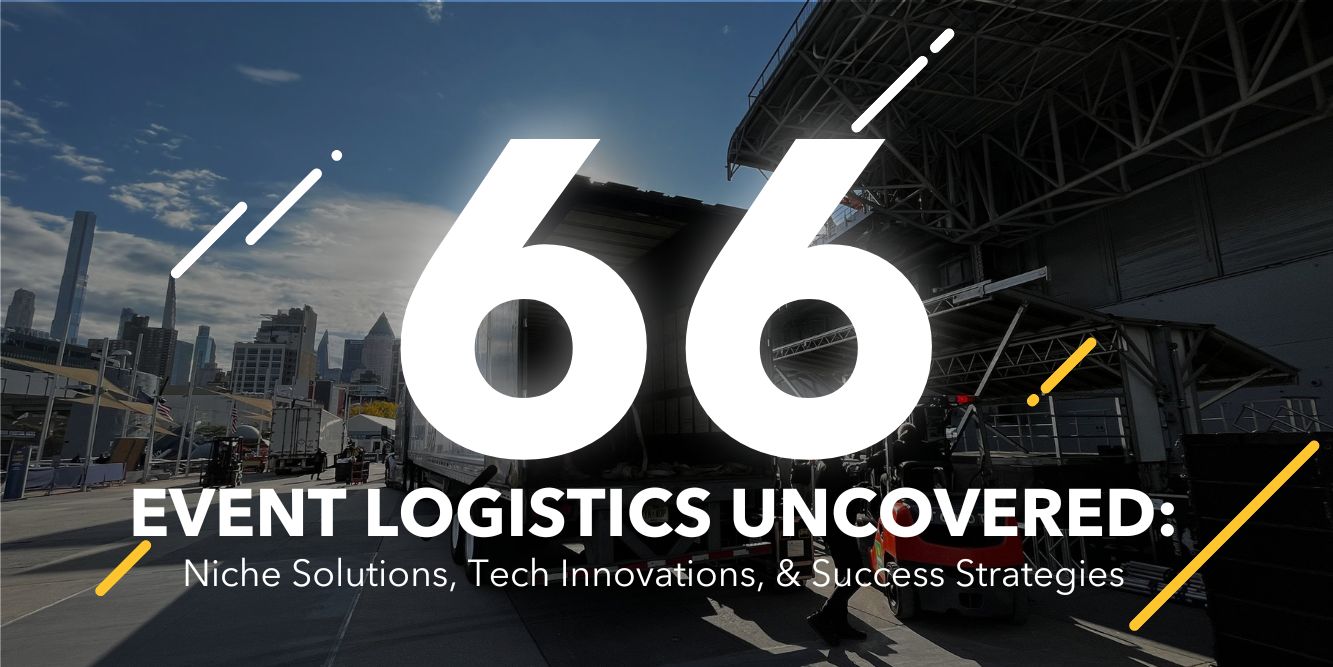What we’re talking about 💬
Listen 🎧
Watch this episode 📺
Read the transcript 📚
Angela Alea: Welcome back to Corralling The Chaos. Today we are gonna dedicate to all things safety and ensuring the safety of all of the event professionals and attendees at events out there. And it’s such a big topic. Given the work and quite honestly, the risk that our industry takes to put on these epic experiences and shows and all the planning that goes into that.
Angela Alea: And we [00:01:00] often talk about the lack of understanding that consumers of events have, right? Like they show up, they love this event, but they really have no idea. , all that goes into planning it, putting it together, the risks that go into kind of building these events. And so they’re just not all, they’re just not privy to all that really kind of happens behind the scenes and the massive amounts of equipment that has to be unloaded, unpacked, set up, tested, and really what I call the technical minefield.
Angela Alea: Typically exists behind stage. No one really sees all that’s happening, you know, behind the curtain. And unfortunately, that just comes with some inherent risks that we all need to be aware of. And so today we wanna welcome Ray Brock, the Director of Safety Services, and he also happens to be LASSO’s safety consultant.
Angela Alea: Ray comes to us today with 28 years of consulting in the employee safety field for various. Some of his proudest moments as a safety professional include partnering with large companies like Home [00:02:00] Depot. I mean, not about you guys, but anytime I go into a Home Depot, I feel at risk, right? With everything moving around.
Angela Alea: So he has done a lot of work with Home Depot and companies like Netflix as well, helping them build effective safety programs. But his real passion is really being in the field, supporting a variety of companies with their onsite efforts to provide a safe working environment. So welcome Ray to the show. We are so glad you are here.
Ray Brock: Thank you for having me today.
Angela Alea: I’m sure in your 28 years you’ve probably seen a number of mishaps, a number of close calls. so we’re thrilled to have you here to kind of give us some guidance and safety is such an important topic, in our space, certainly. But tell us, how did you first get involved in.
Ray Brock: When I was, actually transitioning from high school to college, I had an opportunity to work on a tugboat and, we had a steady run from Mobile, Alabama [00:03:00] to Freeport Bahamas hauling jet fuel. In one of the runs we actually, got to a port and I had a couple of experiences. Our barge, after unloading all of the jet fuel was empty and it’s about, two and a half stories high.
Ray Brock: And I remember, our captain parked the barge next to a string of barges that eventually got you to land. And he said, okay, you guys, you know, you’ve got your free time. You can. You know, go to land. And I said, well, how are we supposed to get there? He said, oh, you just jump across each barge. So the first barge that I came to was about, I don’t know, it’s only about a foot and a half, two feet apart from each other, but it’s a two-and-a-half story drop into the water.
Ray Brock: And then once you’re in the water, you’re pretty much. Gone. cuz the barges go back and forth and [00:04:00] collide into each other. so it took me a while to jump the first barge, but by the seventh barge I was a gazelle, you know, leaping. And I got to the end of it and I thought, wow, why was that so scary at first?
Ray Brock: And then it just got easier and easier. Well, There was no consequence to it. And it, it just got, it started me thinking about safety and then a, a couple of days later while we were there, there was an actual explosion and two fatalities that happened. And at that point forward, I just had a passion for learning.
Ray Brock: Why these hazards happen, how to prevent them and, and the investigative part as well. Yeah. You’re,
Angela Alea: you’re safe until you’re not. Right. That’s, that’s a crazy story so clearly, we’re not the only industry out there that, that has some challenges that’s interesting. Jumping from barge to barge does not sound fun.
Angela Alea: Um, but I get why that catapult of your career, so, makes good sense. Well, tell me a little bit about and, and tell our [00:05:00] audience, you know, when you think about building these events and producing it, you know everyone, you know, an inherent risk is typically these crews, you know, they don’t know each other.
Angela Alea: This might be the first time they’re working together, and so sometimes that adds a different level of complexity or concern because it’s different than when you show up and work the same event with the same people. You kind of know how people operate. You kind of understand that people have the same level of concern for safety.
Angela Alea: And that’s just not always the case in our space. So what are some of the basic things that event companies can do to ensure safety of their crews and their attendees?
Ray Brock: Yeah, I, I think, you know, as, as we’ve worked with, uh, different event companies and different companies that, that come in to support those operations as well, what, what I’ve learned.
Ray Brock: even if you have the same type of equipment, the same type of setup, there’s just no two events that are, are, are ever gonna be the same. And so it really comes down to, [00:06:00] um, doing the best job of evaluating the hazards, uh, really planning for the worst so that if, if something happens, you’re, you’re moving forward in a positive direction.
Ray Brock: So, um, a around pre-planning event, and being able to identify the risks and hazards that can hurt employees. And then also, uh, putting the controls in place for those particular activities and those particular jobs, um, are really setting you would really set yourself up for success. Uh, going through the event, what, what are some of those controls?
Ray Brock: As I was thinking about this presentation today, I, I kind of walked through on a high level. , uh, the, the different stages of the event. And so I look at it from getting to the event. So, you know, motor vehicle accidents, you know, the type of identifying, you know, what equipment are you bringing? Are you having a pull trailer?
Ray Brock: Is [00:07:00] it a box truck you’re using? Um, how are you getting to the event, the route, maybe the time of year, um, environmental conditions around getting to the event as well, and looking at controls around that. Uh, picking your route, understanding, um, the controls around your vehicle, making sure that it’s, it’s operating correctly.
Ray Brock: Um, checking the weather. You know, many times, um, we’ve seen adverse effects happen in, in certain events, especially outdoor events, if, if the weather isn’t evaluated correctly. Uh, and then also just having the background in understanding how to drive in certain conditions. Sometimes people get to a certain area of town, uh, that they may not go to that often.
Ray Brock: They may be flying in just understanding the, the different hazards, um, of the town that you’re in as well. I remember the first time I, I went into DC and I drove around the capitol. The [00:08:00] roads are incredibly confusing and they were designed that way. And, and so, you know, before I got there, I had an understanding that, okay, these, these roads are not gonna.
Ray Brock: the way that I think they should connect, and I, I need to be able to traverse that. Um, and then getting to the event itself, you know, the loading docks present their own hazards, understanding, uh, what, what those hazards are of, of falling off the dock, um, walking around, moving equipment, walking around the, the trucks themselves.
Ray Brock: You know, pedestrian safety is, is paramount. You know, as you’re working in those docks, uh, some of the potential. Security risks and, and working, you know, with the different people in those events. And then, you know, through the, the set up, the event of the event, uh, and the different hazards of working at Heights, working with different tools, having the right tools for the job.
Ray Brock: You know, when, when we look at event companies, [00:09:00] um, and the timing aspect of getting things set up and running the events. Can cause people to, to potentially skip important steps around this, you know? Yeah. There’s stress trying
Angela Alea: to get it set up in time, right? Yes. So that’s a great point.
Ray Brock: Yeah. So I don’t have a hammer right next to me, so I’m just, I’m gonna use the back of the screwdriver.
Ray Brock: Um, and it, it ends up that, you know, the plastic cracks and now we have an eye injury or lacerations. Um, I don’t necessarily have the right step ladder. a frame ladder in order to get to the height I need. So I’ll stand on this chair. You know, I’ll stand on a stack of, uh, cases. You know, they seem so I, you know, throughout the, the entire process and, and you know, then taking down these sets, taking down these, these structures, um, you’re, you’re back at those heights as well.
Ray Brock: And there’s a timing aspect of that [00:10:00] because there, there might be an. in a few hours. It might be event, an event the next day and they need everything struck and, and, um, so I, I would say that, um, just understanding, um, the right tools and equipment that you need and the hazards for the workplace, once again, I, I just can’t emphasize enough.
Ray Brock: It goes back to that pre-planning and pre-planning doesn’t take hours. You know, pre-planning, especially for an activity can just. A couple minutes, two or three minutes to say, okay, I need to get up to this height. I could fall. , what type of precautions do I need to take for this particular job? Yeah.
Angela Alea: And then being able to lead your people through that, right.
Angela Alea: It’s one thing to have a safety program, right? It’s a totally different thing to roll it out, communicate it, train your people on it, make sure they understand it, and make sure we’re holding them accountable for it. Right? Because a lot of companies. They just stop with checking the box. Like we’ve got a safety [00:11:00] plan, right?
Angela Alea: But at the end of the day, you wanna keep your people safe. And the way to do that is to hold them accountable and inspect what you expect, um, and, and doing those extra things. Are you walking around looking for safety hazards and you know, just being very diligent and vigilant to make sure your people are safe.
Angela Alea: But I also think, you know, as a crew member, you also have a responsibility. To contribute to a safe working environment. So as a, as an employee or as a crew member on these events, what are some things they can do to take the initiative to create their own safe working environment
Ray Brock: as a safety professional?
Ray Brock: You know, one of the, the more frustrating, uh, items and injuries that I see are people slipping on, uh, a floor that has, you know, some sort of liquid on it or tripping over. , uh, some sort of item that really shouldn’t be there. And in, in to safety professionals, there’s a, um, [00:12:00] a hierarchy to the type of injuries that you have.
Ray Brock: So, you know, um, there’s a thought process out there that for every, um, 5,000 near misses, you know, there will be 501st aid cases. Um, there will be 50. Serious injuries and five fatalities on it. So, you know, it’s a numbers game, right? The, the more darts that you throw at the dart board, the, the better you’re going to get at hitting the bullseye.
Ray Brock: When you’re thinking about it’s the near misses, how many times did somebody step over that tripping hazard or step into that liquid? It almost get hurt, but didn’t get hurt and then just kept going. Yeah. So I, I think it’s important for employees. Um, to correct hazards as they’re going. Um, fix the hazards.
Ray Brock: If if it’s something that goes above, um, or beyond what you can fix, then say something, you [00:13:00] know, bring it to the attention to someone. Um, if you feel it’s an imminent hazard, and, and this is an OSHA term, you know, OSHA states that the number one reason, um, in OSHA’s hierarchy of visiting. Companies is because somebody’s reported an imminent hazard.
Ray Brock: And this is a hazard that’s an immediate threat, um, to the life and and safety of employees. Um, so this isn’t, you know, a, um, this isn’t a simple tripping hazard. It it is something that could kill someone. So, um, being able to, uh, identify. , being able to identify those incidents and escalating them, um, through your, uh, supervisors and managers is, is paramount.
Ray Brock: And on the supervisors and managers part, it, it’s important for the, uh, up liner management to be able to communicate back to employees [00:14:00] what’s been done. Um, and, and it goes back to what you talked about in, uh, getting people trained.
Angela Alea: Well, let’s talk about training. There’s. , lots of OSHA initiatives. Um, some states are adopting and mandating certain things, whether it’s OSHA 10 or OSHA 30.
Angela Alea: I think Nevada was, um, I think the first to kind of throw down the gauntlet and make it a mandatory requirement, which is, I think a great thing for our industry. Um, but a lot of people just see that as. Yet another requirement. I gotta take the time out of my day to go sign up and, you know, spend 10 hours or 30 hours doing this.
Angela Alea: But to your point, you know, that’s fascinating for every 5,000 mishaps and then you kinda went through that hierarchy, and that’s a small price to pay to keep yourself safe, to keep your colleagues safe. Um, it’s a small price to pay and I think. I think it makes good sense to do, but there’s, there’s a new one out there, um, AB 1775.
Angela Alea: So tell us about that and why that’s so important, since [00:15:00] this one is specific for our industry. So tell everybody about AB 1775.
Ray Brock: Sure. This is, uh, uh, uh, California. Basically a mandatory 10 and 30 hour safety and health course for individuals working in the entertainment industry. The standard goes into, um, and I, I mean, I, I’m a person as, as many people in the industry are that have read it, and this is kind of the way that I, I have seen the standard.
Ray Brock: But, um, basically, um, the contracting entity, uh, or company. , uh, is responsible to ensure that, um, the vendors and, uh, people that are working the event, um, have taken either the 10 or 30 hour course depending on, uh, your position within that company. So at the employee level, we see the, um, 10 hour course, and then the supervisor and manager level.
Ray Brock: The, the [00:16:00] 30 hour course if you’re going to be working that event. Um, so this is so. that would need to be taken prior to coming on site for the event. Um, these 10 and 30 hour courses have been in place for years in the safety industry. Um, it’s, it’s interesting. I, I work in a lot of different industries, um, and these training classes, uh, are available in what’s called general industry.
Ray Brock: Um, This is something event companies are in. They’re in the general industry. Construction has their own set of training, and then maritime has their own set of training as well. Um,
Angela Alea: so the event industry is categorized under the general curriculum.
Ray Brock: Yes, yes. So, uh, the event industry would be the general industry, uh, training on there.
Ray Brock: OSHA has a set of rules to become an authorized instructor in order to train these. Uh, and then they also have approved companies if you’re going to, to do the online option. [00:17:00] So, um, they do allow online options, but there’s probably, I think right now, I think there’s less than 10 companies or maybe right around 10 companies that are actually approved by.
Ray Brock: um, OSHA doesn’t approve much, but they do approve these types of companies and they’re listed on their website. Um, so you just, you need to be careful of the, the companies that you’re engaging in order to do this training. Um, OSHA does state that the online training is, is perfectly acceptable. They prefer, um, An instructor just because the, um, effectiveness of these classes, you know, and, and discussion and being, being able to ask questions and everything.
Ray Brock: And I, and I think, you know, these are minimum training requirements that you have to have in order to, to operate in the industry, however, as you’re taking these, the importance of these is to recognize the hazards that are being taught to [00:18:00] you in order to prevent yourself from getting injured. So keep that in mind.
Ray Brock: I mean, I, I, I know the, the card is, is imperative in order to get on the site, but there’s a reason why these classes are mandated. It’s to prevent your injuries from, you know, prevent injuries from happening. Y that’s
Angela Alea: such a great point that I, I wanna pause and kind of call that out because. for all of you companies out there that, I don’t care if you even just do one show in California.
Angela Alea: I mean, there’s a lot of stuff happening in California and so either a few companies that are based out there, or any of you companies that might do one or two shows a year or more, um, I think that’s a great call out, right? It’s not about the requirement, like, oh, we’ve gotta go get these people certified.
Angela Alea: It’s. Hey, this is an opportunity to make sure everybody’s safe. And that’s the bigger purpose. That’s the bigger point of all of it. And so, yes, it’s hard when you’re moving fast. I mean, the demand for events right now is through the roof. Um, all of you out there are tasked with doing a whole lot more with.
Angela Alea: So many fewer [00:19:00] resources. And so I know the stress and the constraints that you all are under. And so yes, it’s hard when you kind of hear like, great, there’s another requirement, AB 1775 in California that I have to go do that. But it does serve a much bigger purpose and it could keep you from one of those, one of those fatalities that Ray talked about or serious injury.
Angela Alea: Um, and so I think it’s a great thing. So just keep that in mind. The law goes into effect January 1st, 2020. And at Lasso has been, um, very focused on getting our people, OSHA 10 and supervisors, our, our crew chiefs and leads OSHA 30 certified. It’s just an important initiative and one that I hope our industry will.
Angela Alea: Really rally behind. I know everyone is well intentioned, but sometimes when you’re busy, things kind of fall off. And so my hope is we will all rally around this and really do what’s right for the industry and right for our people by making sure they’re equipped with the knowledge to keep everybody safe.
Angela Alea: Because I know that’s what we all want, right? We all wanna make sure everybody’s [00:20:00] safe. Everybody has a good time and has a great event. Ray, do you think other states are gonna follow suit by mandating something similar? I mean, I know Nevada has it, um, right. What, are there other states that are requiring
Ray Brock: this?
Ray Brock: Um, there are, uh, no other states that I know of in, in general industry that, that require the 10 hour or 30 hour course. Um, there. , at least two other states that require it from a construction standpoint. Um, got it. And we also see the requirements coming in if you’re doing work for the state. Um, the state has this as, as a mandate.
Ray Brock: So, so really this is the first time I’ve seen it in a private industry setting for general industry. Okay. Um, and I do wanna just take a step back and, and describe when we talk about the 10 and 30 hour, we’re the 10 hours, literally 10 instructional hours. , uh, of safety, uh, of specific safety subjects. Uh, and the 30 is [00:21:00] 30 instructional hours of, of those safety subjects.
Ray Brock: So if you’re doing them in person, it’s required that 10 hours required to be a two day session. The 30 hour is required to be a four day session because OSHA does not allow you to take more than seven hours in one day. Um, the other item, at least today on this, and, and I. . I wouldn’t be surprised if this changed in the future, but right now, the 10 and 30 are good for life.
Ray Brock: This, this is not a, an annual research requirement or every five years, every three years. If you are an instructor, you’re required every four years to reauthorize, uh, as a, as a trainer. Um, but right now, for the part. taking it once is good for,
Angela Alea: for life. That’s really great to know. I’m sure a lot of people were wondering that how often they have to re-up that, so that’s good to know.
Angela Alea: Right. That’s a, that’s a really high return on your investment. Um Right. Your safety, you know, your safety for life for, you know, investing [00:22:00] 10 hours or 30 hours, you know, and the responsibility on that. 30, if you’re a supervisor, you know, you don’t want someone to get hurt on your watch. That’s something big to carry.
Angela Alea: So I think that’s great. I also didn’t know cuz so much of our industry, What we call 10 hour days. And so that’s also interesting that they require that to be broken up into two days. So that, that makes sense. Right? On the ninth hour, you’re tired. Are you really gonna be paying attention to everything that you need to, to make sure that you’re safe?
Angela Alea: Um, so that, that makes good
Ray Brock: sense. Um, absolutely. They, OSHA looked at that. They also looked at, and this is, uh, onsite instruction. Um, I’m, I’m not sure. , the, uh, companies that automate this through a virtual environment, uh, do it. I, I would also, uh, offer this is not, um, we’re looking for, um, updates on this, literally this month, but OSHA is also moving toward, uh, allowing these classes to be taught in a virtual environment.
Ray Brock: So you have your online self-pace that’s approved through certain [00:23:00] companies, but OSHA is looking to, I, I should say, , the allowance of companies to be, um, to teach these classes in, in this type of environment. Got
Angela Alea: it. Good to know. Really good intel for us all. Thank you for that. Well, I’m sure you’ve seen a lot in your 28 years, so just curious, do you have a story for us either?
Angela Alea: Let’s say a, let’s say a scenario where it was a complete train wreck and you saw so many, uh, potential hazards, or we can go with the story where you’re like, man, this company really had it together. Uh, they had thought of everything. They really invested in the pre-planning, so any events kind of stand out to you?
Ray Brock: Um, I, I would say, uh, this was an outdoor event, but, um, you know, uh, two, two items uh, stood out for me and, and one, it started bad. , uh, the company learned from its mistakes and, and ended up, you know, changing an entire process. [00:24:00] But, um, we, um, we did have a, a company that was erecting, um, tents and structures for an outdoor event.
Ray Brock: Uh, and an employee fell a very good distance. Um mm-hmm. , he was probably. 14 feet in the air as he was straddling between a scissor lift and the structure while he was attaching part of the structure. Uh, so he wasn’t tied off or anything, and the, the scissor lift had a basket and he opened the door was outside of the basket.
Ray Brock: That was probably one of the, um, worst injuries than I’ve, I’ve seen in, in that, uh, field. But I will say this company, Then prevented multiple injuries by, by doing a better job of pre-planning on it. And, and really, I, I can’t think of any particular instance, but there several lives that I think were saved.
Ray Brock: You know what’s interesting in our field is that. It’s, it’s easy to [00:25:00] see the adverse effect of a bad injury, but it’s hard to see the positive effect of the injury that doesn’t happen. So I mean, if, if you’re able to celebrate those wins, you know, if you see something where your safety controls did a good job.
Ray Brock: I totally agree. , make sure you celebrate those wins because, um, it’s hard to quantify the wins. It’s easy to, to quantify the law, you know, the injuries that happen. Uh, absolutely. Because there’s so
Angela Alea: many, even just kind of, you know, accidents that happen in the warehouse, right? Something falls on ’em. They trip and fall, they cut themselves.
Angela Alea: Those are still injuries. Those are still inconveniences. Those are still. Those are still things and hazards, right? It doesn’t always have to be something massive as a loss of life, but there’s so many other smaller things that can be easily prevented by just being intentional. Making sure everyone’s rested, making sure everybody is, uh, vigilant and, and looking for those things.
Angela Alea: And so I think, I think that’s a great point. A a lot of the good doesn’t always, uh, get [00:26:00] celebrated. And so, um, for those of you out there doing all the right things that haven’t had any claims, you should celebrate that and you should kind of tee your own words. I think that’s, I think that’s a great point, right.
Ray Brock: Angela, you’ve also allowed me, uh, on a few site visits. We wanna definitely continue those, but I, I will say I was impressed with the amount of communication that I hear from your work site employees. I mean, just, you know, calling out someone behind you, you know, you know, just the, the different ways, um, that your employees communicate with each other.
Ray Brock: At least on the sites that I visit, it’s been, it’s been very. Good. Well, we,
Angela Alea: we appreciate that. It, it’s a work in progress, right? It’s never, it’s never gonna be done. It’s something we always have to, you know, be in the forefront of our mind. Something we always have to be talking about planning, um, and making sure everybody’s right there with us, you know, with, with valuing the same, you know, that the same way.
Angela Alea: And so I appreciate, I appreciate you saying that. Well, this is great. I hope you know, as we wrap up today, that this is really a reminder to all of us [00:27:00] of the Importa. Of being vigilant when it comes to our safety, the safety of our colleagues. Um, so please, please, please don’t cut corners. I know it’s super stressful.
Angela Alea: It’s a last minute load in, you couldn’t get access to the room, now you’re under the gun. Or, hey, you’ve gotta, you know, dismantle it really quickly and get onto the next one. But please don’t cut corners, um, when it comes to those things and, and make sure you’re rested, make sure you’re putting the things in place and to raise point.
Angela Alea: Invest in the pre-planning, um, that way you’re going in with expectations and can anticipate what could go wrong and have a plan for it. So my hope is all of us can take safety, continue to take safety seriously and make sure we go into this next year with, with a good plan to ensure that everyone is safe and sound, and that way we continue to produce epic events and experiences.
Angela Alea: So thank you Ray Brock for joining. If you all enjoyed what you heard, don’t forget to subscribe and if you have any questions or [00:28:00] comments, reach out to us at podcast lasso.





